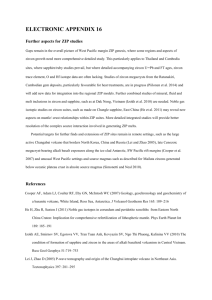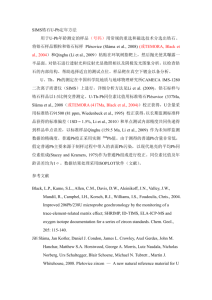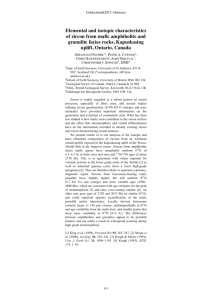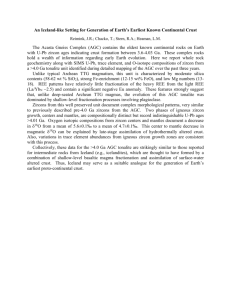Comment on ``Zircon Thermometer Reveals Minimum Melting
advertisement
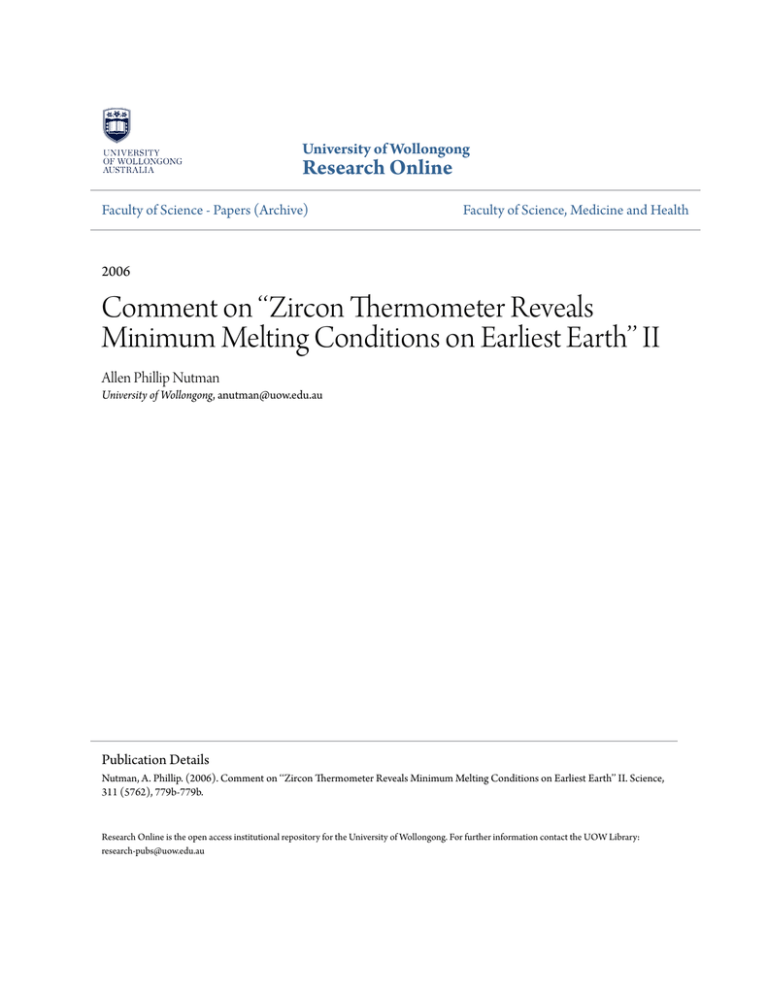
University of Wollongong Research Online Faculty of Science - Papers (Archive) Faculty of Science, Medicine and Health 2006 Comment on ‘‘Zircon Thermometer Reveals Minimum Melting Conditions on Earliest Earth’’ II Allen Phillip Nutman University of Wollongong, anutman@uow.edu.au Publication Details Nutman, A. Phillip. (2006). Comment on ‘‘Zircon Thermometer Reveals Minimum Melting Conditions on Earliest Earth’’ II. Science, 311 (5762), 779b-779b. Research Online is the open access institutional repository for the University of Wollongong. For further information contact the UOW Library: research-pubs@uow.edu.au Comment on ‘‘Zircon Thermometer Reveals Minimum Melting Conditions on Earliest Earth’’ II Keywords melting, minimum, reveals, thermometer, ii, zircon, earth, comment, earliest, conditions, GeoQUEST Disciplines Life Sciences | Physical Sciences and Mathematics | Social and Behavioral Sciences Publication Details Nutman, A. Phillip. (2006). Comment on ‘‘Zircon Thermometer Reveals Minimum Melting Conditions on Earliest Earth’’ II. Science, 311 (5762), 779b-779b. This journal article is available at Research Online: http://ro.uow.edu.au/scipapers/922 Comment on ‘‘Zircon Thermometer Reveals Minimum Melting Conditions on Earliest Earth’’ II Allen P. Nutman Watson and Harrison (Reports, 6 May 2005, p. 841) interpreted low temperatures (~700°C) for Hadean zircons as evidence of the existence of wet, minimum-melting conditions within 200 million years of solar system formation. However, high-temperature melts (>900°C) are zircon-undersaturated and crystallize zircon only after substantial temperature drop during fractional crystallization. Zircon thermometry cannot distinguish between low- and hightemperature Hadean igneous sources. Watson and Harrison(1) presented a geothermometer based on the titanium content of zircon in equilibrium with the titanium-rich phase rutile (TiO2). Although most granites do not contain rutile as an igneous phase, they used it to derive low melt temperatures (~700°C) for the now destroyed source igneous rocks of Hadean pre-4.0 billion years ago (Ga) detrital zircons in the Jack Hills meta-sediments of Western Australia. However, Watson and Harrison’s conclusion may not be robust, because high-temperature melts are mostly zircon-undersaturated, meaning that zircons only grow from them when their temperatures drop into the low-temperature realm of minimum melts(2). Mojzsis and Harrison(3) used the melt temperature versus zircon-saturation relation(4) to show that igneous zircon in one of Earth’s oldest surviving tonalites (>3.8 Ga) crystallized below 775°C. As Mojzsis and Harrison pointed out, this would be almost 200°C less than the temperature at which the (wet) tonalitic melt was originally generated(5) and then emplaced into the crust figure 2 in (3). This is a key feature of the zircon petrology of tonalites - the most common preserved early terrestrial rock(6), because their compositions are grossly zircon undersaturated, typically by a factor of 3 or 4. Zircon saturation, and thus late-stage zircon crystallization, is reached through a substantial temperature drop during fractional crystallization and a shift in residual liquid composition toward ‘granitic’(7). Therefore, the titanium in the zircon thermometer cannot distinguish between zircons grown at <750°C out of initially hot (900- to 950°C) zircon-undersaturated wet tonalite melts and zircons grown from always-cool zircon-saturated minimum wet melts (700- to 750°C). The corollary is that, alone, the titanium in the zircon thermometer is inappropriate to establish the generation and emplacement temperatures of the melts that spawned the pre-4.0 Ga Jack Hills zircons. A diagnostic petrologic feature of zircons in minimum wet melts like those Watson and Harrison proposed to have identified in the Hadean is that they are marked by partly resorbed premagmatic inherited cores mantled by the igneous zircon(8). This is because they have not exceeded their zirconium saturation temperature(4, 9). The internal structure of >4.0 Ga Jack Hills zircons revealed by cathodoluminescence imaging shows that some grains consist of >4.0 Ga cores with 3.7 to 3.4 Ga rims(10). Therefore, sedimentary abrasion did not destroy all such relations in the Jack Hills zircons. It should also be noted that recorded core-rim relations with different pre-4.0 Ga ages are rare(10). This suggests that in most cases the thermometry on pre-4.0 Ga zircons records zircon saturation temperatures of melts generated at higher temperatures. References and Notes 1. E. B. Watson, T. M. Harrison, Science 308, 84 (2005). 2. C. F. Miller, S. M. McDowell, R. W. Mapes, Geology 31, 529 (2003). 3. S. J. Mojzsis, T. M. Harrison, Earth Planet. Sci. Lett. 202, 563 (2002). 4. E. B. Watson, T. M. Harrison, Earth Planet. Sci. Lett. 64, 295 (1983). 5. P. J. Wyllie, M. B. Wolf, S. R. van der Laan, in Greenstone Belts, M. J. de Wit, L. D. Ashwal, Eds. (Oxford Univ. Press, Oxford, 1997), pp. 256–295. 6. A. P. Nutman, V. R. McGregor, C. R. L. Friend, V. C. Bennett, P. D. Kinny, Precamb. Res. 78, 1 (1996). 7. J. S. Beard, P. C. Ragland, M. L. Crawford, J. Geol. 113, 589 (2005). 8. I. S. Williams, Trans. R. Soc. Edinb. Earth Sci. 83, 447 (1992). 9. E. B. Watson, Trans. R. Soc. Edinb. Earth Sci. 87, 43 (1996). 10. A. J. Cavosie, S. A. Wilde, D. Liu, P. W. Weiblen, J. W. Valley, Precamb. Res. 135, 251 (2004). 11. I acknowledge support from ARC grant DP0342794 and thank I. S. Williams and R. A. Armstrong for discussions on zircon petrology. 5 October 2005; accepted 3 January 2006 10.1126/science.1120977 TECHNICALCOMMENT Research School of Earth Sciences, The Australian National University, Canberra, ACT 0200, Australia, E-mail: Allen.Nutman@anu.edu.au
